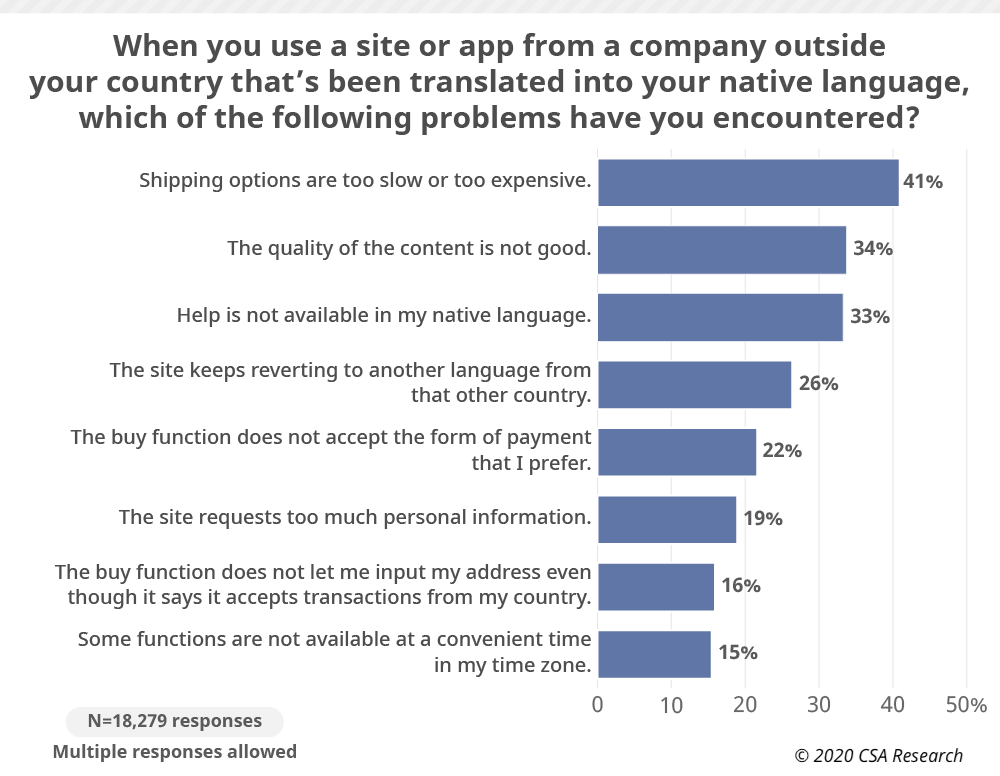-
How we help
- Does my software work?
- Does it work for all users?
- Global Growth Toolbox
- Industries
-
Platform
- Platform
- Integrations
- Browse all test types
- Add-on services
- Pricing
- Resources
The ultimate guide to reinvent your localization strategy
If you’re expanding into new markets, it’s vital to have a localization strategy in place. Learn about how to create one, and what you need to succeed.

How to build a great localization strategy
If you’re thinking about moving into new markets, how much thought have you given to your localization strategy? It can be extremely easy to get pulled into being an in-house translation agency and forget to set a strategic agenda.
We’re going to be looking at what a localization strategy entails and how to develop one that helps your business make the right kind of impact.
What does a “localization strategy” look like?
A localization strategy is your strategy or plan for building a localization function suited to delivering your internationalization goals. In your strategy, you’ll want to devise an approach to localization challenges which will include:- Determining (and communicating) ROI for localization
- Creating visibility on issues, mistakes and bugs in non-US markets
- Creating visibility on what users want in non-US markets
- Managing stakeholders and workflows
An optimal localization strategy should address these issues and create the same high-quality consumer experience for customers everywhere. To achieve this, it will encompass research on cultural norms, customer behavior, and purchasing preferences to generate actionable insights.
Additionally, there should be an emphasis on selecting the right KPIs and metrics to establish how well things are going, as well as having a clear plan of how to implement changes.
Establishing your localization strategic framework
Here’s our steps for localization- Set clear strategic goals for the program as a whole. This will help you home in on the right metrics to choose later on to measure progress.
- Get your localization team together. Depending on your circumstances and budget, this may mean hiring new talent or working with external agencies.
- Conduct detailed audience and market research. This is arguably the most important step of the whole process. It’s the knowledge engine that drives the operation.
- Decide on scope. You need to make a decision about what exactly you’re focusing on. It might seem easy to say “just translate everything” but this is too much of a scattergun approach to be useful in most cases. Instead, decide what’s the most important aspects for you to localize.
- Select your metrics. These can be process-based, such as what percentage of selected content has been localized at any given time. But there should also be some audience-specific metrics e.g. NPR scores from customer feedback in the target market.
- Review and revise. Although localization will start with an initial big push, it’s an ongoing process too. Use insights from ongoing customer research to feed into future localization work.
Roles to consider on your localization team
At the heart of any localization team is a program or project manager to ensure that everything ticks along as expected. (Whereas project managers oversee individual projects; program managers preside over multiple projects, a strategy). However, you’re likely to use labor from the following profiles:
- Content specialists: to identify which content should be selected for localization; to manage the translation of that content.
- Linguists: to translate content. As far as the in-house management of this goes, it will probably include terminology management and the upkeep and maintenance of your libraries and core translations in the TMS system.
- Engineers: some localization teams employ engineers directly to deliver the localized change requests from other departments.
- Designers: to tweak the design-after-translation and ensure that the product continues to look great.
- Product managers: the gatekeepers.
- Analysts: to help you
- Testers or reviewers: to do quality assurance checks. Ideally, they should be native speakers of the target language and familiar with local cultural nuances.
- For each of these, you have a choice of doing internally, or outsourcing. But even with internal hires, the question of whether to use somebody internal to the l10n team or work with stakeholders becomes a question.
‘I don’t know if it’s advice that’s going to work universally… but for me, what worked really well was pioneering with our stakeholders.’
‘You might be tempted to ask for more heads in your team. But actually – what you need is international engineers, who need to sit in the engineering org. And you need international analysts, who need to sit within the analyst team. And maybe you need designers – but they need to be in line with their relevant pockets of the company’.
– Francesca Di Marco, Head of Internationalization & Design at Pinterest
Benefits of a localization strategy
Putting effort into the initial planning gets results. Here are a few of the benefits you’ll see.
1/ Getting it right first time
Expanding into new markets is a serious undertaking. In terms of logistics, distribution, legal compliance—it’s a lot. If the project is not supported by a solid localization strategy, you may not connect with your target audience and the launch could fail.
2/ Boosting the customer experience
Adapting your content to a local audience not only shows respect, but helps drive customer engagement. According to CSA Research, a third of consumers using translated websites or apps encounter two key problems: the content quality is poor, and help isn’t available in their native language. A strong localization strategy can avoid these mistakes.

Saving time and money
Having a proper strategy in place at the start saves time and money in the long run. That’s because it can help you avoid making costly mistakes such as hitting resource bottlenecks that cause delays.
Establishing a concrete program
If localization is done on an ad hoc basis, it can be very hit and miss. There may be inconsistency in terms of which types of content are included, and the overall result can be pretty unsatisfactory. A sound localization strategy prevents this by establishing a solid framework for everyone to follow.
Why is a localization strategy important?
Understanding why localization is important is one thing; appreciating how vital it is to have a strategy in place to achieve it is quite another. So let’s list a few of the upsides.Maximizing opportunities
- Hit the ground running when you launch, increasing your chances of success
- Make the most of your in-house team’s skills
- Gain transferable insights during the process of honing the strategy
Minimizing waste
- No time is lost to duplicated tasks
- Saves money because you plan your budget carefully beforehand
- Resource deployment is streamlined
Establishing your department as a leadership department
- Good planning boosts the bottom line
- Well-organized cross-team collaboration increases employee engagement
- Your department reaps the kudos for a successful launch
Aligning your department with your business OKRs
- Keeps you focused on key business goals
- Everyone involved is on the same page
- Makes sure your department is at the core of operations
Calculating the ROI of localization
We’ve already touched upon the fact that calculating the ROI of a localization project can be challenging. Nevertheless, a data-driven approach is absolutely essential to make a success of your localization project.
How do you calculate the costs accrued by the extra complexity?
First, break the project down into its core constituent parts. Focus on one market at a time. Once you’ve established the scope of the job, you should be able to estimate costs from the ground up. These will include basics like translation costs, but should also take account of your in-house staff’s time. Revise your calculations with real-time updates as the project progresses.
How do you identify your key metrics?
Take a cue from your overall business OKRs. If the principal objective is to capture a specific market share, say, then metrics such as monthly sales growth, total number of customers acquired, and retention and churn rates could all feature.
How do you measure the effect you’re having on your key metrics?
Often, metrics are easy to measure but difficult to assign credit for. For example, if you’re launching an app internationally, then measuring the increase in downloads in each region and comparing the performance across different markets will be easy to do. But how much of that is due to localization efforts?
Try to use a mixture of different types of KPI to help get around this. For example, you can combine insights from technical KPIs like organic traffic and conversion rates with customer-focused ones like CSAT scores and sentiment analysis to get a more complete picture. Qualitative surveys will have their place here too - you can specifically ask how customers found the localized app or product.
Prioritizing your localized changes
In the context of a go-to-market launch, it can be useful to reduce the scope of content localization in order to achieve the launch faster.
The Pleo way: what does a localization MVP look like?
Pleo offers an expense management solution to a wide variety of businesses. In early 2022, it began a localization push that saw it launch successfully in ten new markets in ten months.

Key to this success was the localization team’s primary focus on core content. Other than the apps themselves, this meant the website and the most popular landing pages, as well as some of the more popular articles published in the help center.
They managed to reduce their go-to-market time from seven weeks to three. They came from ‘a ready playbook, a core asset list, and all the dedicated resources frontloaded… having glossaries and style guides prepared.’ (read the blog)
Building out recommendations
When you’ve begun to understand the ROI of changes happening at the minute, and you have solved your production pipeline to produce localized changes in a timely manner, you can begin to build out recommendations and
“When I have [the NPS] for all the markets I’m serving, I can finally start to speak the same language that a PM is speaking. I can corroborate my strategic instinct… if you ask to develop a feature, the data has to corroborate what you’re asking for.”
– Francesca Di Marco, Head of Internationalization & Design at Pinterest
‘The strategy needs to be aligned across the teams from above – including the localization team. This quarter you’re working towards X, next quarter Y, and so forth. So it’s tough to become an expert in one metric, or a particular goal, but if you’re serving cross functionally for the business, you need to identify the business goals you can have a genuine impact towards, rather than having separate business goals.’
– Yngvild Troan, Localization Manager at Deliveroo
Think about quality
Global App Testing can help you work towards your quality goals in localization. Our 48-hour product checks either work for engineering teams in an SDLC timeline; or to get the register of what a local user thinks of your product in so that you can drive the l10n agenda in your organization.
If you’re curious, check out how we can help you by localizing your functional checks and running product investigations in local markets.
Examples of localization strategy done right
Let’s take a look at a few successful localization strategy examples from the real world.
Netflix
Netflix’s journey from small online DVD rental service to multinational media megastar has become the stuff of business legend. And as an example of localization strategy, it’s up there with the best of them.

Key to its success has been its focus on effective multi-language support. For example, it uses an approach called pseudo-localization to scale its UI design for different markets. The software allows for additional space around each piece of text during the development phase to accommodate languages that use more characters than English does.
PUBG
PUBG is a battle royale-style game that launched in December 2017 and has around 284 million active players as of the beginning of 2023. From the start, it was involved in its own head-to-head battle with Epic Games’ Fortnite, so struggled to dominate the US market. However, its focus on localization led to early success, particularly in Asia.
As well as offering multi-language support, PUBG alters game content to tailor it to each market. For example, it made the game less violent to please Chinese regulators.
Slack
Work cultures vary between countries, so a platform for work communications has to take account of that. Over half of Slack’s active users are situated outside the United States, so it must be doing something right.
Slack’s playful brand voice was reportedly one of the trickiest elements to localize. Working with linguists and local stakeholders enabled it to strike the right balance between formality and informality in each market.
